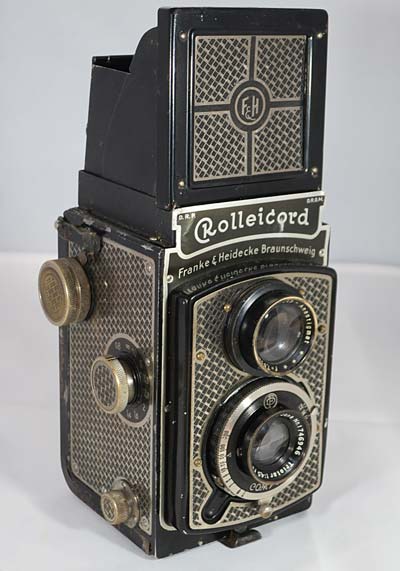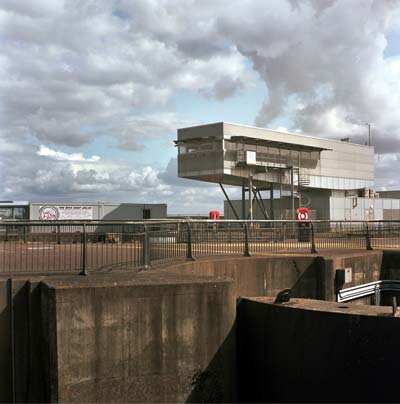Franke & Heidecke Rolleicord I
Specification

| Manufacturer | : | Frank & Heidecke |
|---|---|---|
| Produced | : | 1933 - 1936 |
| Classification | : | Medium Format |
| Body Type | : | Twin lens reflex |
| Construction | : | Metal |
| Film Type | : | 120 |
| Film Width | : | 62mm |
| Image Size | : | 6 x 6 cm |
| No. of Images | : | 12 |
| Lens Type | : | Zeiss Triotar |
| Focus Type | : | Variable |
| Focal Length | : | 75mm |
| Focal Range | : | 0.8m - inf. |
| Aperture Type | : | Iris |
| Apertures | : | f/4.5 - f/32 |
| Shutter Type | : | Leaf |
| Shutter Speeds | : | T,B, I(1/300s - 1s) |
| Size Open (w x h x d) | : | 90 x 197 x 93 mm |
| Size Closed (w x h x d) | : | 90 x 133 x 93 mm |
| Weight | : | 875g |
Art Deco Credentials
![]()
![]()
![]()
![]()
![]()
Iconic: Famous, well-known and celebrated
I consider this camera to warrant 5 stars for the following attributes:
- produced during the main Art Deco period
- elaborately patterned metal faceplates
- patterned faceplates to front, sides and top
- elaborate pattern on wind, focus and spool knobs
Description
The Rolleicord was a popular medium-format twin lens reflex camera made by Franke & Heidecke (Rollei) between 1933 and 1976. The first Rolleicord, the Rolleicord I was introduced in November 1933. It was a simplified version of the Standard Rolleiflex, with a cheaper 75mm Zeiss Triotar lens and a knob instead of the crank for advancing the film. The Rolleicord I was also available with a plain leatherette covering at a later date. The nickel plated version was also referred to as the Rolleicord I ’Tapeten’ meaning wallpapered. This model has the letters DRP on the left and DRGM to the right on the front of the camera. DRP stands for 'Deutsches Reichs Patent' which is the German Reich Patent and DRGM stands for 'Deutsches Reichs Gebrauchs Muster' which is basically a copyright for the name.
Reflex viewing is through the second lens viewfinder. The viewfinder has a full-size ground glass focusing screen. Cross hairs are used on the focusing screen. It has parallax adjustment, a magnifier in hood and a frame finder.
Film advance is indicated by a physical counter after initially setting to 1 in red window. The red window does not indicate the correct frame number as the film is advanced. The exposure counter is operated by wheel rolling on the film. Film advance is not coupled to shutter.
The Compur shutter is capable of shutter speeds varying from 1/300s down to 1s. The aperture range is f/4.5 to f/32. It can focus between 0.8m and infinity. The removable back has depth-of-field and exposure guide tables printed on it.
How to Use
The highest speed (1/300s) is probably no longer accurate and may run slow. This would lead to overexposure.
If you don't want to bother with an exposure meter, follow the guide shown. It is based on the 'Sunny 16' rule. Film is so forgiving and will produce acceptable results even when overexposed by 2 or 3 stops or underexposed by 1 stop.
Remember that the exposure guide in the camera user manual may not be helpful as it is based on the use of old film with a low ISO value.
The tables assume that the sun is at least 30 degrees above the horizon - that's 10am - 5pm on a summer's day in the UK.
If you are not sure about the light level, err on the side of overexposure - i.e. assume the smaller f number.
Where there is a choice, a larger f number will give a larger depth of field.
For the slower speeds, you may need a tripod to stop blur through shake.
Using ISO 100/125 film
| Weather Conditions | Shadow Detail | Shutter Speed (s) | ||
|---|---|---|---|---|
| 1/25 | 1/50 | 1/100 | ||
 Sunny SunnySnow/Sand | Dark with sharp edges | f/32 | f/22 | |
 Sunny Sunny | Distinct | f/32 | f/22 | f/16 |
 Slight Overcast Slight Overcast | Soft around edges | f/22 | f/16 | f/11 |
 Overcast Overcast | Barely visible | f/16 | f/11 | f/8 |
 Heavy Overcast Heavy Overcast | None | f/11 | f/8 | f/5.6 |
 Open Shade Open Shade/Sunset | None | f/8 | f/5.6 | f/4.5 |
Photographs taken with this Camera
Using Portra 160 120 film.


